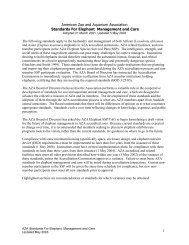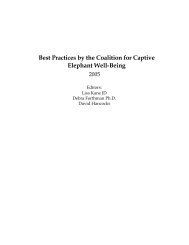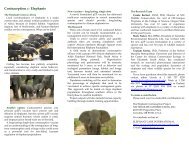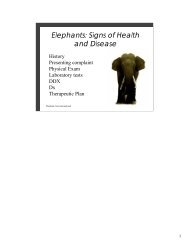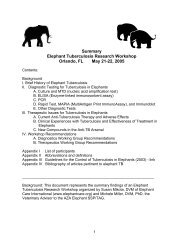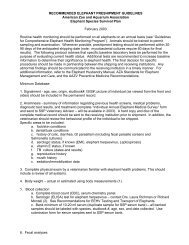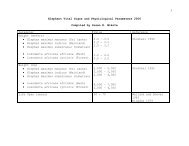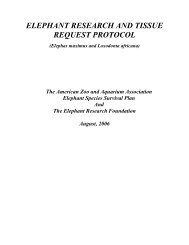Nepal Elephant TB Control and Mgt Action Plan.pdf - Elephant Care ...
Nepal Elephant TB Control and Mgt Action Plan.pdf - Elephant Care ...
Nepal Elephant TB Control and Mgt Action Plan.pdf - Elephant Care ...
- No tags were found...
Create successful ePaper yourself
Turn your PDF publications into a flip-book with our unique Google optimized e-Paper software.
<strong>Nepal</strong> <strong>Elephant</strong> Tuberculosis <strong>Control</strong> <strong>and</strong>Management <strong>Action</strong> <strong>Plan</strong> (2011-2015)Segregaon should be instuted as soon as testresults indicate. If elephants are to be treated,they should be rested <strong>and</strong> not used for work ortourism unl they have completed 30 consecuvedays of treatment (Group 2) or 90 consecuvedays of treatment (Group 3). If very old elephantsare to be maintained under permanentquaranne they should never be used for work ortourism.Segregaon should ideally take place in aseparate locaon (such as the Kasara segregaonfacility for government elephants). Privateelephants may be segregated at their homefacilies if the following guidelines are strictlyobserved:a. Segregated elephants should be kept at anappropriate distance (minimum 15 meters)from other animals within the camp <strong>and</strong>should not be bred.b. Segregated elephants should be housed suchthat the adjacent stalls on either side areempty. These elephants should be maintainedon a high plane of nutrion. Gram <strong>and</strong>produce (carrots, pumpkins, sugar cane etc.)should be added to the diet along with theclose monitoring of their daily raons.c. Separate tools should be used to clean <strong>and</strong>feed segregated elephants <strong>and</strong> they should beh<strong>and</strong>led last.d. <strong>Elephant</strong> h<strong>and</strong>lers should wear N-95 maskswhen working in close proximity to theelephant <strong>and</strong> should wash their h<strong>and</strong>s a erh<strong>and</strong>ling, cleaning, or feeding.1.5 <strong>TB</strong> Treatment ProtocolGeneral ConsideraonsThe government will arrange for treanggovernment-owned elephants. Private ownerswill be responsible for treang privatelyownedelephants. Treatment protocols arebased on established treatment regimenssuccessfully used in the U.S. Treatment plans forindividual elephants will be developed underthe supervision of the <strong>TB</strong> <strong>Plan</strong> veterinarian.Treatment protocols will be updated as newinformaon becomes available.The goal is to prescribe <strong>TB</strong> treatment forelephants in <strong>Nepal</strong> using the currently availablescienfic informaon with the hope of curingthe disease. The intent is to strive to achieve thecurrently recommended dosages with allowanceto adjust the dosages for each individualelephant as needed to achieve compliance whileminimizing side effects.It is extremely difficult to underst<strong>and</strong> the severityof <strong>TB</strong> disease that an individual elephant mayhave. It may not be possible to completelycure <strong>TB</strong> in elephants with advanced disease (>50% of the lung involved). So far, no st<strong>and</strong>ardmeasurements have been developed for“complete cure” at this me. See post-treatmentmonitoring guidelines below.Drug doses are best determined by obtaining anaccurate scale weight. A portable weighing scaleis available at the <strong>TB</strong> <strong>Plan</strong> office at NTNC. Thescale requires a pla$orm for the elephants tost<strong>and</strong> on. There are currently pla$orms at NTNC,Kasara, the Chitwan Ha&sar, <strong>and</strong> Bardia.If scale weighing is not possible, the weight maybe esmated using the chest girth method. Thechest girth should be measured 3 mes <strong>and</strong>averaged to ensure accuracy. The chest girth ismeasured immediately behind the front leg. Theweight is calculated from the following formula(Hile et al. 1997):Weight in kg = 18.0 (Heart Girth in cm) – 3336.Group 1 elephants have no work restricons.Group 2 elephants that elect prophylacc11




